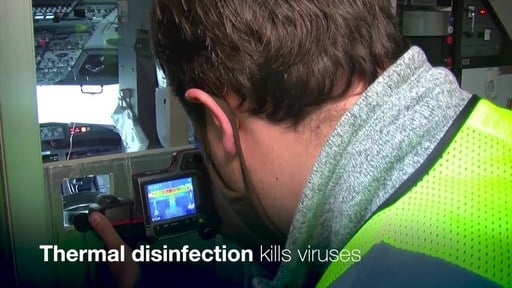Aerospace
Turning Up the Heat on COVID-19 in the Flight Deck

SEATTLE, Dec. 15, 2020 /PRNewswire/ — Boeing [NYSE: BA] and the University of Arizona put an age-old technique, thermal disinfection, to use in the fight against COVID-19. Researchers validated that applying heat to surfaces, especially on hard-to-clean flight deck equipment, effectively eliminates SARS-CoV-2.
Results indicate that the virus can be destroyed by more than 99.99% after three hours exposure to temperatures of 50 degrees Celsius (120 degrees Fahrenheit) and will still effectively kill more than 99.9% of the virus at 40-degree Celsius temperatures (104 degrees Fahrenheit).
“Passenger and crew safety are our top priorities — that extends from the cabin to the flight deck,” said Michael Delaney, who leads Boeing’s Confident Travel Initiative (CTI) efforts. “Thermal disinfection could deliver another valuable tool to destroy COVID-19 on sensitive and difficult-to-reach components that protect pilots.”
Boeing completed the testing as part of its CTI effort to support customers and enhance the safety and well-being of passengers and crews during the COVID-19 pandemic. Thermal disinfection testing was conducted in a protected laboratory environment at the university using flight deck parts and SARS-CoV-2, the virus that causes COVID-19, this fall.
The flight deck is one of the most challenging areas to sanitize using traditional chemical disinfectants. In areas with sensitive electronic equipment, heat has the ability to disinfect without adverse effects from cleaners. The flight deck is designed to withstand temperatures up to 160 degrees Fahrenheit (about 70 degrees Celsius), which makes thermal disinfection a safe, practical and effective sanitization method.
As air travel is fundamentally disrupted by the global COVID-19 pandemic, Boeing and the University of Arizona continue to test recommended cleaning methods in a lab against SARS-CoV-2 and other similar viruses to further validate their efficacy.
Read our other post : Lufthansa turning Airbus A350-900 into a Flying Research Lab
Watch video of Top 12 Fuel Efficient Airplane for long haul flight

Aerospace
Boeing Transfers Rocket Stage to NASA, Paving Way for Human Moon Mission

Boeing has achieved a significant milestone by providing NASA with the second core stage of the Space Launch System (SLS) rocket.
This crucial component, crafted at NASA’s Michoud Assembly Facility (MAF), is set to propel the Artemis II crew into lunar orbit, marking humanity’s return to deep space after a 50-year hiatus.
The monumental Boeing-built rocket stage, the largest element of the Artemis II mission, will embark on a journey aboard the Pegasus barge, traveling 900 miles to NASA’s Kennedy Space Center.
Comparison of two legendary aircraft B777x vs B747 aircraft:Click here
Upon arrival, it will be meticulously integrated with other essential Artemis II components, including the upper stage, solid rocket boosters, and NASA’s Orion spacecraft within the iconic Vehicle Assembly Building. This intricate integration process is a vital step toward the eagerly anticipated Artemis II launch, slated for 2025.
“Boeing-built products helped land humankind on the moon in 1969, and we’re proud to continue that legacy through the Artemis generation,” remarked Dave Dutcher, vice president and program manager for Boeing’s SLS program. “Together, with NASA and our industry partners and suppliers, we are building the world’s most capable rocket and paving the way to deep space through America’s rocket factory in New Orleans.”
NASA, Lockheed Martin Reveal X-59 Quiet Supersonic Aircraft:Click here
The delivery of Core Stage 2 marks a significant achievement in the evolution of the SLS rocket. Towering over 200 feet and powered by four RS-25 engines, this core stage, coupled with two solid-fueled booster rockets, will generate a staggering 8.8 million pounds of thrust. This immense power is crucial to launching Artemis II and future missions into the vast expanse of space.
The SLS rocket stands unparalleled in its capability to transport both crew and substantial cargo to the moon and beyond in a single launch. Its extraordinary capacity will facilitate the delivery of human-rated spacecraft, habitats, and scientific missions to destinations including the moon and Mars, ushering in a new era of space exploration.
-

 Travel1 week ago
Travel1 week agoAir India to Expand US Operations with Three New Routes After a Decade
-

 Travel2 weeks ago
Travel2 weeks agoWhy We Should Avoid These Stamps in a Passport
-

 Airlines1 month ago
Airlines1 month agoInvestigations Reveal Fake Chinese Titanium in Boeing and Airbus Jets
-

 Tech4 weeks ago
Tech4 weeks agoChina’s CATL Plans 1,800-Mile Electric Plane Launch by 2027
-

 Airport3 days ago
Airport3 days agoTop 10 Largest Airports in the World by Size
-

 Aerospace4 weeks ago
Aerospace4 weeks agoChina’s Fighter Jets Turn Wings into Autonomous Drones
-

 Airlines4 days ago
Airlines4 days agoAir India Rolls Out A350s for Delhi-New York JFK and Newark Routes
-

 Defence3 weeks ago
Defence3 weeks agoBoeing Enhances Chinook with New Engines and Block II Upgrades at $96 Million







